Proto-planetary discs
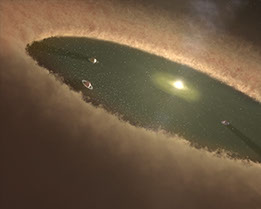
Credit: NASA
Shortly after their discovery, a number of independent observations showed that brown dwarfs and isolated planetary mass objects (IPMO) also harbor discs. Observations of these discs are critical to our understanding of their formation.
Some years ago, I led or participated to surveys aimed at measuring the frequency of proto-planetary discs around substellar objects. I conducted or participated in 10μm surveys with the VLT and Spitzer to search for discs around young brown dwarfs and IPMO. The figure to the left shows that for a given age, discs seem to be more frequent among lower mass objects, suggesting that their lifetime is larger, in good agreement with theoretical predictions. The sample size is too small to derive a reliable IPMO disc frequency (red dot, upper limit), but the existence itself of discs around such objects is a challenge for the latest theories.
The study of brown dwarf discs is complicated by their weak luminosity. Using the unprecedented sensitivity of Spitzer, my collaborators identified the brightest brown dwarf disc known at the time. Using various ground and space based facilities, we collected the most complete data set available for a brown dwarf (cf. Fig. to the left). The quality of these data allowed us to perform a detailed modeling and to derive the geometrical and compositional properties of the disc. Our analysis showed that this brown dwarf disc is similar to that of more massive TTauri stars, suggesting that similar mechanisms are at work on each side of the substellar limit. The presence of large processed grains confirmed previous results showing that all the material required for the formation of planets is present in brown dwarf discs. We also found a rather high level of crystalinity among the dust grain, which is puzzling considering the low temperature of the central source, and suggests that transient event (flares) might be responsible for the processing of these grains.
More recently, we took upon to refine the measurements of disc fractions in nearby associations. Previous surveys (e.g Mamajek 2009, Haisch 2001) were mixing data obtained with very different instruments and sensitivities. They also mixed nearby associations (largely made of low mass stars) and distant clusters (where observations are strongly biased towards massive stars), making a direct comparison of the disc fractions difficult.
A. Ribas, a student at CAB/ESA under the joint supervision of B. Merín and myself, spent the first year of his PhD compiling and studying an exhaustive list of confirmed members of nearby (<500pc) associations. By gathering optical, near- and mid-IR photometry (obtained with Spitzer and WISE), and by comparing the spectral energy distributions to theoretical predictions for photospheric emission, we were able to derive disc fractions for a large sample (>2300 sources). The results, obtained in a consistent and coherent way for the entire sample, are illustrated in the left figure, and show a typical disc disappearence time of ~10Myr.
The same study led to another interesting result. We split the sample in two parts:
a) primordial discs, that display a strong excess at short wavelength
b) evolved discs, that display an excess only at walevength longer than 24 microns. These typically include transitional discs (discs with a gap or a hole) and debris discs.
and derived disc fractions for the two populations. Even though the current uncertainties are large, there seem to be an increase of the evolved disc fraction around 10Myr.
If confirmed, this preliminary result would match the observations reported by Currie et al. 2008 for the double cluster h and X-Per. It also matches theoretical predictions that around this age, dynamical stirring of the discs results in an increased collision rate between planetesimals which replenishes the disc with dust.
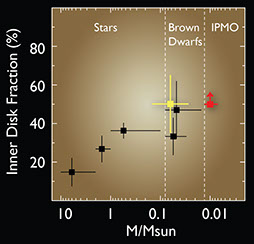
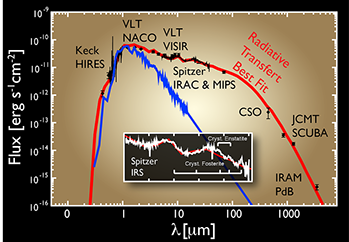
Discs are ubiquitous to star formation. They are also the place where planets are formed. Observations of these discs are critical to our understanding of stellar and planetary formation. Up to recently, their study was limited by the technology, their luminosities being at the limit of sensitivity of infrared and millimeter instruments. The advent of new ground-based instruments (VLT/VISIR, Gemini/T-ReCS, GTC/Canaricam, Plateau de Bure, ALMA) and space observatories (such as Spitzer, AKARI, and Herschel) not only led to the discovery of large samples of protoplanetary discs over the entire mass spectrum, but also allowed detailed studies of their physical properties.
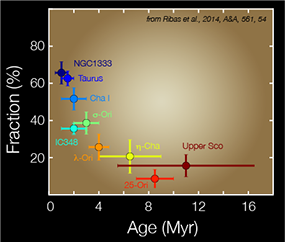
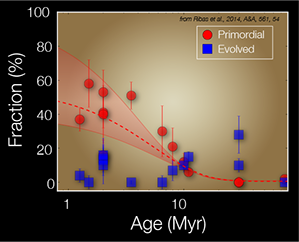
© Last Update: 13-02-2017 by H. Bouy
Photograph Credit: Yuri Beletsky